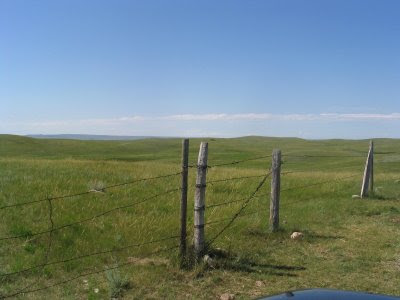
Fences have become a dominant feature of the landscape wherever native grass remains on the Great Plains. I may dream of a day when the prairie will be unfettered from the agricultural realities that have placed tame grazers and grains where once there were wild grazers and grasses, but for now the best way to hold onto the remaining native grassland is to support good grazing practices and provide an economic basis for increasing the acreage of land covered by perennial grasses.
That means more consumers choosing to buy meat and dairy products from local producers who raise their animals on native grass in ways that sustain the health of the prairie and its watersheds. And it means encouraging all producers, whether they graze on native or tame grass, to finish their animals on grass and not on feedlot grain (see posting for March 15). The ecological rationale for grass-fed meat and dairy products is unassailable, not only because of what a grass-fed regime can do for grassland ecology, but because buying local grass-fed meat and dairy will reduce your contribution to greenhouse gas emmissions.
Grass-fed meat and dairy is substantially better on the greenhouse emissions side of things, even though a steer eating grain releases no more methane than a steer eating grass in a pasture. Under a grass-fed model, however, there would have to be much more grassland to raise animals, which would provide the permanent green cover and leaf surface required to absorb CO2 thereby compensating for a larger portion of the greenhouse gas effect caused by methane from the grazing animal's manure, ultimately building more of the biomass necessary to help fix carbon in the soil in the decomposition cycle, which in turn maintains the fertility of the prairie. In feedlots, the majority of the carbon in the methane produced by decomposing manure simply escapes into the atmosphere. A single cow pat dropped on grassland and decomposing on the soil surface releases less methane than it does in the piles found at feedlots where the manure decomposes anaerobically. Finally, because of the machinery, fossil fuel, fertilizers, and pesticides used to grow and transport the grain used in a feedlot, a pound of grain-fed beef has a much greater overall carbon contribution than a pound of grass-fed beef. (Reference: Union of Concerned Scientists, “Greener Pastures: How Grass-fed Beef and Milk Contribute to Healthy Eating”, http://www.ucsusa.org/food_and_environment/sustainable_food/greener-pastures.html.
In the next To Make a Prairie posting I will cover human health benefits from eating grass-fed meat and dairy products. It's all in the Omega-3s.





Hey - I recognize that gate!
ReplyDeleteHa ha. Is that the hood of your truck peeking into the shot from below?
ReplyDelete